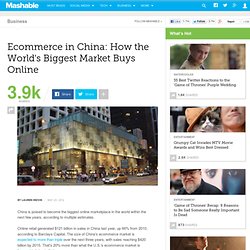

Jack Ma Takes in $5.75 Bil – And Takes on China's Real Estate Barons. Jack Ma flashes a few signs at China’s mall developers Not satisfied with sales of RMB 35 billion ($5.75 billion) over his e-commerce sites on a single day, Internet billionaire Jack Ma has decided to take on China’s real estate industry.

For the good of the people, of course. Turning a Celebration into an Online Manifesto Appearing on television to spotlight the sales success of Taobao.com and its up-market T-Mall twin on China’s unofficial ecommerce day this November 11th, the Chairman of Alibaba Group indicated that the new sales records set by the group’s online shopping sites during the event were only the beginning. And, as his company gears up for a 2014 IPO that some analysts expect to be bigger than Twitter’s, Ma made it clear that China’s real estate market is his next target. Indian e-Commerce: What does the future look like? Depending on who you talk to, e-Commerce is either the greatest sunrise sector in India or a completely dead one.

Opinions on an e-Commerce startup can range from “The Amazon of India” to “Going bust by the end of the quarter”. While there is no doubt that some players in the Indian e-Commerce scene are doing well, the perception of the future of these e-Commerce startups remains sharply divided. So what’s really going on? To understand what the future of e-Commerce in India can look like, lets peek into what’s happening in other emerging markets around the world that are presumably ahead of the curve from India. Or you can compare with Brazil (which is presumably more like India), where there are an estimated 40 million online shoppers.
India maybe behind the curve on the numbers, but they are growing fast, and when they reach the 200-300 million online shoppers, you can safely assume that there will at least be as many e-Commerce players in India as there are in China. CEO of Vietnam’s biggest e-store reveals his secrets to success. Vietnam has one of the most bullish e-commerce markets in the region.

A report from the Vietnam E-Commerce and Information Technology Agency (VECITA) found that 57 percent of the Vietnamese population has bought goods or services online. 96 percent of Vietnamese people sees buying goods online as normal. By VECITA’s previous estimates, the e-commerce market is currently worth $700 million and will grow to $1.3 billion by 2015. Leading the growth of this market are e-commerce sites like VC Corp, VNG, Rocket Internet, Tiki, and Vat Gia.
Alibaba doubles down on NFC payments. Alibaba, the Chinese internet giant that’s quickly expanding into financial services, announced on Saturday that it would partner with Yintai, a major Chinese retailer, to offer NFC payments in its retail stores through Alibaba’s Alipay e-wallet.

Jinghua reports that starting tomorrow, Alipay users can go to any one of Yintai’s 37 properly-equipped retail stores and purchase products simply by opening the Alipay e-wallet app on their phones, and swiping it above a sensor. The move, Alibaba’s first major extended foray into offline payments, is no surprise. Last week, Alibaba announced that Alipay’s e-wallet app had racked up 100 million registered users. The revelation came after the company’s record-smashing online sales on Singles Day.
Given the relative newness of NFC, it’s likely that only the app’s most loyal users use the service to complete online transactions. (Editing by Terence Lee) (Image via Flickr user faungg’s photo) Jack Ma Takes in $5.75 Bil – And Takes on China's Real Estate Barons. Alibaba doubles down on NFC payments. CEO of Vietnam’s biggest e-store reveals his secrets to success. Indian e-Commerce: What does the future look like? Smartphones in China: Taking a bite out of Apple. E-commerce in India begins to give physical retail a run for its money.
"The alarm clock hasn't even gone off yet," Jeff Bezos, founder and chief executive of global e-commerce behemoth, Amazon, says of the US e-commerce market, about 20 years after it came about in that country.

By that yardstick, the market in India isn't even a speck, considering only 11 per cent of the country's population uses the internet. But there are definite signs soon, Indian e-commerce, pegged at $9.5 billion (Rs 47,349 crore) last year (including online travel bookings) according to a study by the Internet & Mobile Association of India and KPMG, would be a force that would take on physical retail head on, possibly forcing the closure of many brick-and-mortar stores. That the market stood at just $3.8 billion (Rs 19,249 crore) in 2009 and is projected to grow to $12.6 billion (Rs 62,967 crore), according to the study, by the end of this year shows the potential in this space. Snapdeal, too, sounds positive. Ecommerce in India: Small Merchants Finding Niches. Indian marketplaces bring to mind colorful winding roads lined with family and individually run storefronts where retailers can build personal relationships with their customers and deals are negotiated through these relationships.

It’s no wonder that when the Prime Minister of India, Manmohan Singh, approved opening Indian retail to foreign retailers such as Walmart, local retailers strongly objected. While individual merchants oppose foreign retailers like Walmart for fear of losing their business, corporations and farmers see the introduction of foreigners as a way to modernize the archaic Indian retail supply chain. But whereas commerce in India faces this David versus Goliath dilemma, the Indian market is evolving very fast in terms of adoption of online commerce. Indians are now beginning to value the convenience of online shopping and many traditional businesses are now eagerly looking to join the online retailing space.
Puneet started Nirogam after meeting research scientist Dr. Ecommerce in China: How the World's Biggest Market Buys Online. China is poised to become the biggest online marketplace in the world within the next few years, according to multiple estimates.

Online retail generated $121 billion in sales in China last year, up 66% from 2010, according to Barclays Capital. The size of China's ecommerce market is expected to more than triple over the next three years, with sales reaching $420 billion by 2015. Study: Global Ecommerce to Hit $1.2 Trillion This Year, Led by Asia. Ecommerce sales are forecast to increase 17% to $1.2 trillion worldwide this year, led by growth in the Asia-Pacific region.

Indonesia is expected to experience greater ecommerce growth, proportionately speaking, than any other country this year, according to estimates published Thursday by eMarketer. Online sales are expected to increase 71.3% to $1.8 billion. China, whose ecommerce market is already more than 100 times larger than Indonesia's, is expected to grow the second fastest, increasing 65.1% to $181 billion. (Other groups believe China is generating much more than that already.) SEE ALSO: Ecommerce in China: How the World's Biggest Market Buys Online Collectively, the Asia-Pacific region is expected to generate $388.8 billion in online sales in 2013, up nearly a quarter from 2012. North America is still the world's largest ecommerce driver, estimated to pull in $419.5 billion this year. E-commerce in China: The Alibaba phenomenon. U.S. to get coveted Alibaba IPO after Hong Kong talks founder.